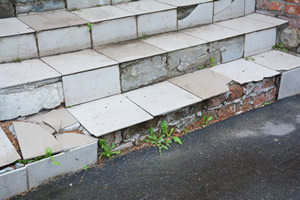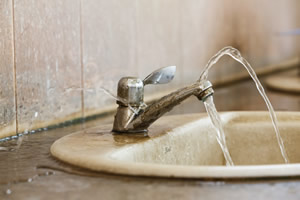Why Deferring Maintenance Now Will Cost You Later
Your environment is more than simply the place you are; the atmosphere you occupy affects you on a biological level, sending signals to your body and mind that influence your health in a variety of ways.

PHOTO © RADOVAN1
Take a minute to imagine your go-to happy place, that place where you feel at peace. Now try to list what makes it your happy place. Somewhere on that list, you’ll likely include physical aspects that provide you with comfort there: color, temperature, safety, availability of certain items, etc. That’s because your environment plays a significant role in the way you feel. Your environment is more than simply the place you are; the atmosphere you occupy affects you on a biological level, sending signals to your body and mind that influence your health in a variety of ways.
In addressing the role this plays out in schools, consider how much time students spend in their school environment. Out of the 120 hours in a Monday to Friday week, roughly 35 of them are spent inside a school facility. That’s over a quarter of their time during the week under the influence of facility conditions, certainly enough to require educational leaders to closely examine the kind of atmosphere they’re providing to students in their care. Where should you look to see how well your institution is providing for the comfort and security of your students?
Check your deferred maintenance backlog.
To you or your maintenance department, that old HVAC system might just be an expense in next year’s budget; that cracked classroom window might just be something you haven’t gotten around to yet, and that squeaky hallway door might just be a nuisance you’ll get someone to work on after more important things are taken care of. To a student, however, that old HVAC system could be what’s causing their allergies due to poor air quality. That cracked window is what’s making them cold in their math class. That squeaky door is what’s distracting them during a lesson or test. Deferred maintenance isn’t just an issue for your maintenance department; it affects the ecosystem of your entire organization.
Numerous studies over the last 20 years point to the link between equipping students with a proper environment and their physical and emotional wellbeing, as well as their academic performance. The difference in student performance in above-standard facilities compared to sub-standard is five to 17 percentile points.1 The need for well functioning facilities magnifies in the case of students with learning impairments. Students with autism, ADHD, developmental delays and sensory challenges are especially inhibited by environments that are distracting due to design, temperature and lighting. What can a deficiency in these areas result in?
- Student and faculty illness, particularly where air quality is concerned
- Absenteeism of both students and faculty, which impairs student success
- Difficulty concentrating and thinking abstractly
The problem many schools are facing now is that their facilities weren’t built to accommodate what is needed for a modern educational environment or with the awareness we now have about the learning environment’s role. Older facilities lack the ability to properly regulate temperature, provide optimal air quality or comfortably house large class sizes, and they definitely weren’t designed to facilitate today’s technology and security needs. Add deferred maintenance on top of facility age and poor design, and you’ve got a recipe no institution wants to end up with.
And it’s not just about the environment deferred maintenance creates — deferring maintenance is also expensive.
What’s the Cost?
If deferred maintenance has got your institution in a bind, rest assured you’re not alone. It’s a problem many schools face. There are a variety of reasons these tasks pile up, but one thing is universal: This backlog of work that is put off for a future date accumulates and can quickly get out of control. The result is that you actually may end up spending more later on, and this can have a negative effect on your entire organization.

PHOTO © 7TH SON STUDIO
When you don’t perform routine preventive maintenance (PM), those tasks that were repairs or proactive work can quickly evolve into a replacement. An article by FacilitiesNet recently estimated that the cost of replacing an asset can actually be 30 times the cost of the early intervention2. This means that even though putting off an initial repair may save you money, in the long-term it will be much more harmful for your budget. What could have been the cost of a half hour of employee manpower could be extremely expensive and become a drain on your resources.
Currently, US schools occupy around 7.5 billion square feet of facility space. If it costs about $258 per square foot to build a new school, then the current replacement value (CRV) of every school in the US is nearly $2 trillion.3 In 2016’s State of Our Schools report, it’s estimated that, when referring to capital, the nation should be spending roughly $77 billion per year (4 percent of CRV) to “regularly upgrade existing facilities’ systems, components, fixtures, equipment and finishes as they reach the end of their anticipated life expectancy; systematically reduce the backlog of deferred maintenance that has accumulated; and alter existing facilities to respond to changing educational requirements.”3 It’s easy to see that not investing proactively in this way will lead to greater budgetary constraints later, and these aren’t numbers schools want to tack costs onto. Reducing the risk of full system failure and facility decline is not only more efficient and cost-effective than regular scheduled maintenance; it provides a safer and more conducive learning environment.
It’s easy to prioritize other needs over facility needs, but think about it this way: If you don’t have a roof on your home, or your air conditioning system went down in the middle of a hot day, how much focus would you put on cooking dinner that night? Likewise, if a building fails or a major system goes down, how can we expect our students and staff to focus on learning? A lack of preventive maintenance compromises the overall mission of any organization, especially education. Consider the $100M+ investment that was made toward your learning environment. Preventive maintenance is an incremental investment that can use a school’s operational budget to protect the assets critically needed for an adequate learning environment. Proper preventive maintenance ensures the optimal life of equipment with minimal costs, therefore maximizing the core mission of the institution.
How Do You Start a PM Program?
Preventive maintenance is essential to:
- Save money and reduce emergencies
- Reduce lifecycle costs
- Improve customer service
- Increase energy efficiency of buildings and equipment
- Improve safety and reduce risk
- Provide a better learning environment
But though preventive maintenance is critical to perform regularly, it can be a daunting task to begin. Those who have paved the way recommend beginning with work order management, followed by a preventive maintenance schedule. A work order management system, best operated through a CMMS (computerized maintenance management system), allows you to schedule maintenance, track inventory, monitor energy consumptions and plan for future capital needs. With a proper preventive maintenance protocol in place, you’re able to cut unnecessary spending, decrease emergency work safety risks and provide a healthier environment for students.
Once you have a plan, finding the budget to enact it can be equally overwhelming for many schools. An increase or redistribution of funds is rarely done without thorough justification, and justification can’t happen without tracking what’s going on inside your facility as is stands. With a CMMS, you can track key performance indicators that illustrate exactly what funding is needed.
Getting away from deferred maintenance and improving the condition of your facilities is not easy, nor is it quick. It’s a step-by-step process that involves growing pains, collaboration and a lot of going back to the drawing board. Once on its way, however, it has the power to transform your school and your students from the inside out. That’s why you do it and why you can get through the process of figuring out how.
If the mission of a school is to facilitate the learning that enables students to show up fully for the future in front of them, then we have to provide the environment in which that learning can happen. Our schools house a variety of students, all with different needs, and it’s our responsibility to deliver the shelter that allows them to move up that hierarchy. Nothing changes if nothing changes, so the first step in improving your facilities is deciding what change to start with, be it purchasing a CMMS, developing a committee or doing a budget analysis. The key is to start somewhere. Just start, and remember you don’t have to do it alone. Even if you only take one step toward ending your deferred maintenance backlog this year, you’ll be a step further than you were before.
SOURCES
1 Filardo, M.; Vincent, J.; Sullivan, K. (2018). Education Equity Requires Modern School Facilities. Retrieved from https://static1.squarespace.com/static/5a6ca11af9a61e2c7be7423e/t/5ba23b3688251b659c2f9eff/1537358671343/Education+Equity+Requires+Modern+School+Facilities.pdf
2 Millán, N. (2016). The Real Cost of Deferred Maintenance. Retrieved from https://www.facilitiesnet.com/maintenanceoperations/tip.aspx?id=38366
3 Filardo, M. (2016). State of Our Schools: American’s K-12 Facilities. Retrieved from https://centerforgreenschools.org/sites/default/files/resource-files/2016-state-of-our-schools-report.pdf
This article originally appeared in the School Planning & Management July/August 2019 issue of Spaces4Learning.